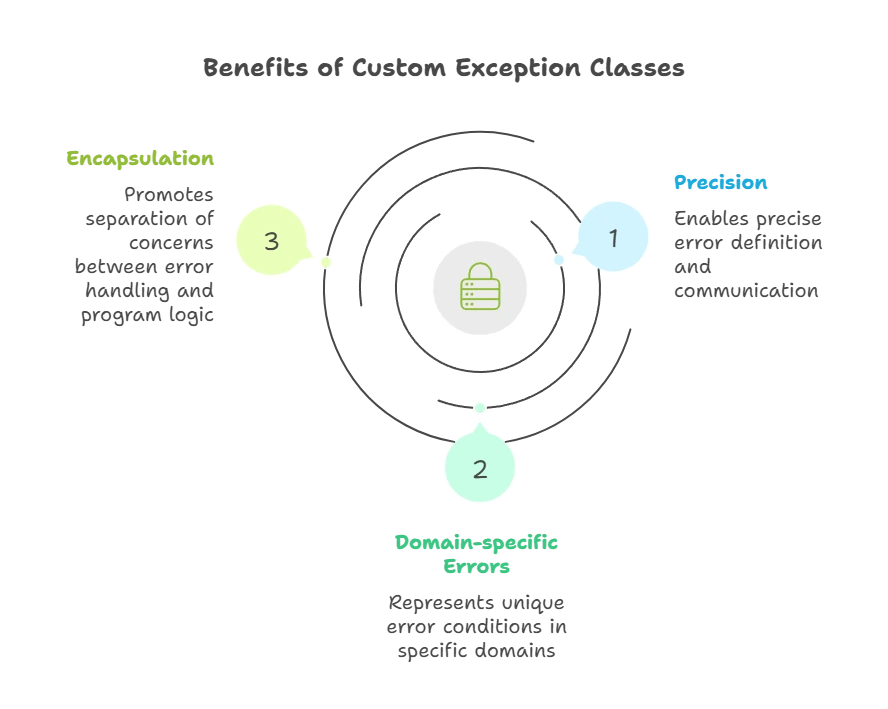Custom exception classes in C++ are user-defined types that extend the functionality of the standard exception classes provided by the C++ Standard Library. They allow programmers to create specialized exceptions tailored to specific error conditions encountered in their programs.
Why Use Custom Exception Classes?
Custom exception classes provide several benefits
- Precision: They enable programmers to precisely define and communicate the nature of an error, leading to clearer error messages and more targeted error handling.
- Domain-specific Errors: In applications with domain-specific logic, custom exception classes can represent unique error conditions specific to that domain.
- Encapsulation: By encapsulating error details within custom exception classes, programmers promote encapsulation and maintain a separation of concerns between error handling and regular program logic.

Basic Syntax and Usage of Custom Exception Classes
Custom exception classes in C++ allow programmers to define their own exception types tailored to specific error conditions encountered in their programs. This section covers the basic syntax and usage of custom exception classes.
#include <iostream>
#include <stdexcept>
class MyException : public std::exception {
public:
MyException(const std::string& message) : msg(message) {}
const char* what() const noexcept override {
return msg.c_str();
}
private:
std::string msg;
};
int main() {
try {
throw MyException("Custom exception occurred!");
} catch (const MyException& e) {
std::cerr << "Caught a custom exception: " << e.what() << std::endl;
}
return 0;
}
// output //
Caught a custom exception: Custom exception occurred!
Explanation:
- Custom Exception Class Definition:
- We define a custom exception class named
MyExceptionthat inherits fromstd::exception. - The class has a constructor that takes a
std::stringparameter to initialize the error message. - We override the
what()method from the base class to return the error message.
- We define a custom exception class named
- Throwing Custom Exceptions:
- Inside the
tryblock in themain()function, we throw an instance ofMyExceptionwith the message"Custom exception occurred!".
- Inside the
- Catching Custom Exceptions:
- The
catchblock catches the exception of typeMyExceptionby reference. - We access the error message through the
evariable and print it to the standard error stream.
- The
Benefits:
- Precision: Custom exception classes allow for precise definition and communication of error conditions, leading to clearer error messages and more targeted error handling.
- Flexibility: Programmers can define custom exception classes tailored to the specific needs of their applications, providing flexibility in error handling strategies.
- Consistency: By following a common convention, where custom exception classes inherit from
std::exceptionand override thewhat()method, developers maintain consistency in error reporting and handling.
Advanced Techniques with Custom Exception Classes
In this section, we explore advanced techniques for designing and using custom exception classes in C++. These techniques include hierarchical exception types, chaining exceptions, and providing additional context in exception messages.
Hierarchical Exception Types:
Hierarchical exception types involve organizing custom exception classes into a hierarchy, where each subclass represents a more specific category of error.
#include <iostream>
#include <stdexcept>
class FileIOException : public std::runtime_error {
public:
FileIOException(const std::string& message) : std::runtime_error(message) {}
};
int main() {
try {
throw FileIOException("Error while reading file!");
} catch (const FileIOException& e) {
std::cerr << "Caught a file I/O exception: " << e.what() << std::endl;
} catch (const std::exception& e) {
std::cerr << "Caught a generic exception: " << e.what() << std::endl;
}
return 0;
}
// output //
Caught a file I/O exception: Error while reading file!
Explanation:
- In this example, we define a custom exception class
FileIOExceptionthat inherits fromstd::runtime_error. FileIOExceptionrepresents a specific category of errors related to file I/O operations.- Inside the
main()function, we throw an instance ofFileIOExceptionwith the message"Error while reading file!". - The first
catchblock specifically catches exceptions of typeFileIOExceptionand prints a custom error message. - If any other exception is thrown that is a subclass of
std::exception, it will be caught by the secondcatchblock, which prints a generic error message.
Chaining Exceptions: Chaining exceptions involves capturing and preserving information about the original exception while throwing a new exception.
Providing Additional Context in Exception Messages: Custom exception classes can include additional context in their error messages to provide more information to the user or developer.
Importance: Understanding and utilizing custom exception classes is essential for effective error handling in C++ programming. By mastering the creation and usage of custom exception classes, programmers can write cleaner, more robust code that gracefully handles exceptional situations with precision and clarity.
Custom exception classes in C++ empower programmers to create specialized exceptions tailored to specific error conditions encountered in their programs. By leveraging custom exception classes, developers can enhance error reporting, improve error handling, and create more robust and maintainable software applications.Happy coding !❤️
